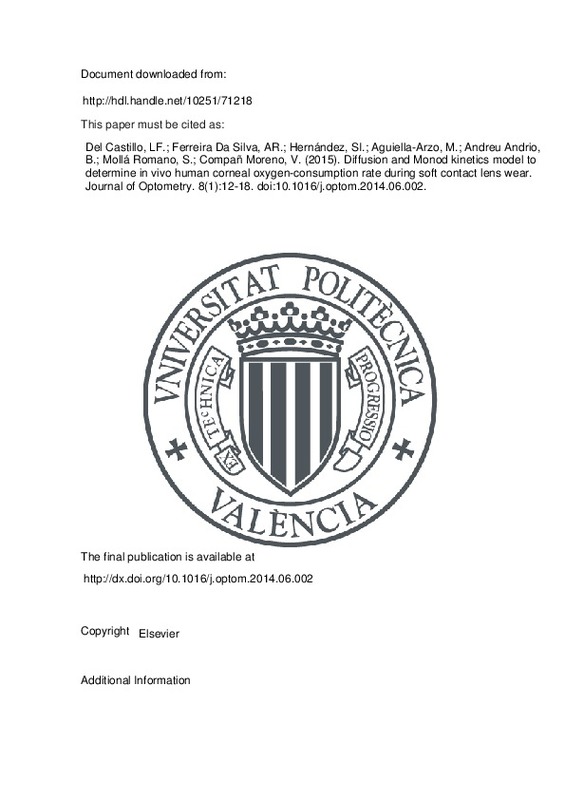JavaScript is disabled for your browser. Some features of this site may not work without it.
Buscar en RiuNet
Listar
Mi cuenta
Estadísticas
Ayuda RiuNet
Admin. UPV
Diffusion and Monod kinetics model to determine in vivo human corneal oxygen-consumption rate during soft contact lens wear
Mostrar el registro sencillo del ítem
Ficheros en el ítem
| dc.contributor.author | Del Castillo, Luis Felipe
|
es_ES |
| dc.contributor.author | Ferreira da Silva, Ana R.
|
es_ES |
| dc.contributor.author | Hernández, Saúl Iván
|
es_ES |
| dc.contributor.author | Aguiella-Arzo, Marcelo
|
es_ES |
| dc.contributor.author | Balado, Andreu
|
es_ES |
| dc.contributor.author | Mollá Romano, Sergio
|
es_ES |
| dc.contributor.author | Compañ Moreno, Vicente
|
es_ES |
| dc.date.accessioned | 2016-10-05T10:02:18Z | |
| dc.date.available | 2016-10-05T10:02:18Z | |
| dc.date.issued | 2015-03 | |
| dc.identifier.issn | 1888-4296 | |
| dc.identifier.uri | http://hdl.handle.net/10251/71218 | |
| dc.description.abstract | PURPOSE: We present an analysis of the corneal oxygen consumption Qc from non-linear models, using data of oxygen partial pressure or tension (P(O2) ) obtained from in vivo estimation previously reported by other authors. (1) METHODS: Assuming that the cornea is a single homogeneous layer, the oxygen permeability through the cornea will be the same regardless of the type of lens that is available on it. The obtention of the real value of the maximum oxygen consumption rate Qc,max is very important because this parameter is directly related with the gradient pressure profile into the cornea and moreover, the real corneal oxygen consumption is influenced by both anterior and posterior oxygen fluxes. RESULTS: Our calculations give different values for the maximum oxygen consumption rate Qc,max, when different oxygen pressure values (high and low P(O2)) are considered at the interface cornea-tears film. CONCLUSION: Present results are relevant for the calculation on the partial pressure of oxygen, available at different depths into the corneal tissue behind contact lenses of different oxygen transmissibility. | es_ES |
| dc.language | Inglés | es_ES |
| dc.publisher | Elsevier | es_ES |
| dc.relation.ispartof | Journal of Optometry | es_ES |
| dc.rights | Reserva de todos los derechos | es_ES |
| dc.subject | Consumo de oxigeno de la cornea | es_ES |
| dc.subject | Corneal oxygen consumption | es_ES |
| dc.subject | Corneal oxygen permeability | es_ES |
| dc.subject | Corneal oxygen pressure | es_ES |
| dc.subject | Monod kinetics model | es_ES |
| dc.subject | modelo cinetico de Monod | es_ES |
| dc.subject | permeabilidad al oxigeno de la cornea | es_ES |
| dc.subject | presion del oxigeno en la cornea | es_ES |
| dc.subject.classification | MAQUINAS Y MOTORES TERMICOS | es_ES |
| dc.subject.classification | FISICA APLICADA | es_ES |
| dc.title | Diffusion and Monod kinetics model to determine in vivo human corneal oxygen-consumption rate during soft contact lens wear | es_ES |
| dc.type | Artículo | es_ES |
| dc.identifier.doi | 10.1016/j.optom.2014.06.002 | |
| dc.rights.accessRights | Abierto | es_ES |
| dc.contributor.affiliation | Universitat Politècnica de València. Departamento de Termodinámica Aplicada - Departament de Termodinàmica Aplicada | es_ES |
| dc.description.bibliographicCitation | Del Castillo, LF.; Ferreira Da Silva, AR.; Hernández, SI.; Aguiella-Arzo, M.; Balado, A.; Mollá Romano, S.; Compañ Moreno, V. (2015). Diffusion and Monod kinetics model to determine in vivo human corneal oxygen-consumption rate during soft contact lens wear. Journal of Optometry. 8(1):12-18. doi:10.1016/j.optom.2014.06.002 | es_ES |
| dc.description.accrualMethod | S | es_ES |
| dc.relation.publisherversion | http://dx.doi.org/10.1016/j.optom.2014.06.002 | es_ES |
| dc.description.upvformatpinicio | 12 | es_ES |
| dc.description.upvformatpfin | 18 | es_ES |
| dc.type.version | info:eu-repo/semantics/publishedVersion | es_ES |
| dc.description.volume | 8 | es_ES |
| dc.description.issue | 1 | es_ES |
| dc.relation.senia | 282240 | es_ES |
| dc.identifier.pmcid | PMC4314625 | en_EN |







![[Cerrado]](/themes/UPV/images/candado.png)

